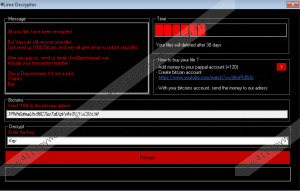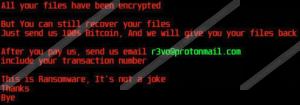BigEyes Ransomware Removal Guide
The entrance of ransomware infections never goes unnoticed. The same can be said about the infiltration of BigEyes Ransomware. Even though this harmful malicious application enters computers unnoticed, users soon realize that it is inside their systems because they discover a bunch of encrypted files. This infection locks all the most valuable users’ files, including pictures, videos, documents, and more. Specifically speaking, it targets the following directories: %USERPROFILE%\Desktop, %USERPROFILE%\Videos, %USERPROFILE%\Documents, %USERPROFILE%\Pictures, and %USERPROFILE%\Music. Luckily, it does not encrypt files located in the Windows OS folder. Ransomware infections are set to lock files on compromised machines not without reason. Cyber criminals behind them use these infections for money extortion. You will be told to send money to them too if you ever encounter this ransomware infection. It goes without saying that you should not do that. If you make a payment and crooks do not send you the decryptor after receiving your money, you will not get your money back either. Therefore, you should focus on the BigEyes Ransomware removal instead. Once this infection is gone, you could restore your files for free if you have their copies.
Ransomware infections are extremely nasty threats because their entrance always results in the loss of a great number of personal files. If BigEyes Ransomware ever infiltrates your computer, a bunch of your valuable files will be locked too. All encrypted files get the .lime extension appended, so we are sure it will not take long for you to find out which of them have been affected by this ransomware infection. After encrypting files on victims’ computers, it drops two files: #Decryptor.exe and #BackGround.png. The .exe file launches the ransomware window with a ransom note, whereas the .png file is set as Desktop background – it also contains a ransom note. If users read the message left for them, they soon find out what the reason they cannot open the majority of files on their computers is. On top of that, they find out that the only solution to the problem is paying money to cyber criminals. Yes, you are told that you will get your files back only if you pay 100 USD and then contact crooks by writing an email to r3vo@protonmail.com; however, you should know that there are no guarantees that cyber criminals behind BigEyes Ransomware will act as they say, i.e. unlock your data. Therefore, you should not send money to them. No matter you pay money to them or not, you must fully erase BigEyes Ransomware from your system.
Without a doubt, ransomware infections infiltrate users’ computers without their knowledge; however, they usually contribute to their entrance to a great extent. Researchers at 411-spyware.com say that people often allow ransomware infections to enter their computers by opening malicious attachments. In the case of BigEyes Ransomware, you could have allowed it to enter your system after opening a malicious .doc or .pdf attachment. Also, it could have entered your system because your RDP credentials are unsafe. Once inside the system, this threat creates a Value called #Decryptor in the Run registry key (HKCU\Software\Microsoft\Windows\CurrentVersion\Run). Then, the encryption of files starts and, after it, two files are dropped on compromised machines. It is quite sophisticated malware, as you can see, but you still need to remove it fully from your system no matter how hard it is. Unfortunately, we cannot guarantee that you will not discover new malware on your computer in the future, but you can lower your chances of encountering a harmful threat again by acquiring and installing a powerful security application on your computer. It will surely help you to prevent bad software from entering the system.
You need to remove BigEyes Ransomware as soon as possible if it has entered your system and encrypted files on your computer because it will stay active on your system if you do nothing and, as a consequence, might encrypt all your new files. Its removal will not be very simple because it makes modifications in the system registry and drops files on affected computers, but you should still be able to erase it yourself if you follow our removal guide (see below). Alternatively, you can scan your computer with an automated scanner. Unfortunately, your files will not be unlocked for you.
Delete BigEyes Ransomware
- Click X if you see the window of the ransomware infection on your Desktop.
- Tap Win+R on your keyboard.
- Enter regedit in the box you see and click OK.
- Access HKCU\Software\Microsoft\Windows\CurrentVersion\Run.
- Locate the #Decryptor Value.
- Right-click it and click Delete.
- Close Registry Editor.
- Access Desktop (%USERPROFILE%\Desktop).
- Remove two files: #BackGround.png and #Decryptor.exe.
- Remove all suspicious files downloaded recently.
- Empty Recycle bin.
BigEyes Ransomware Screenshots:




